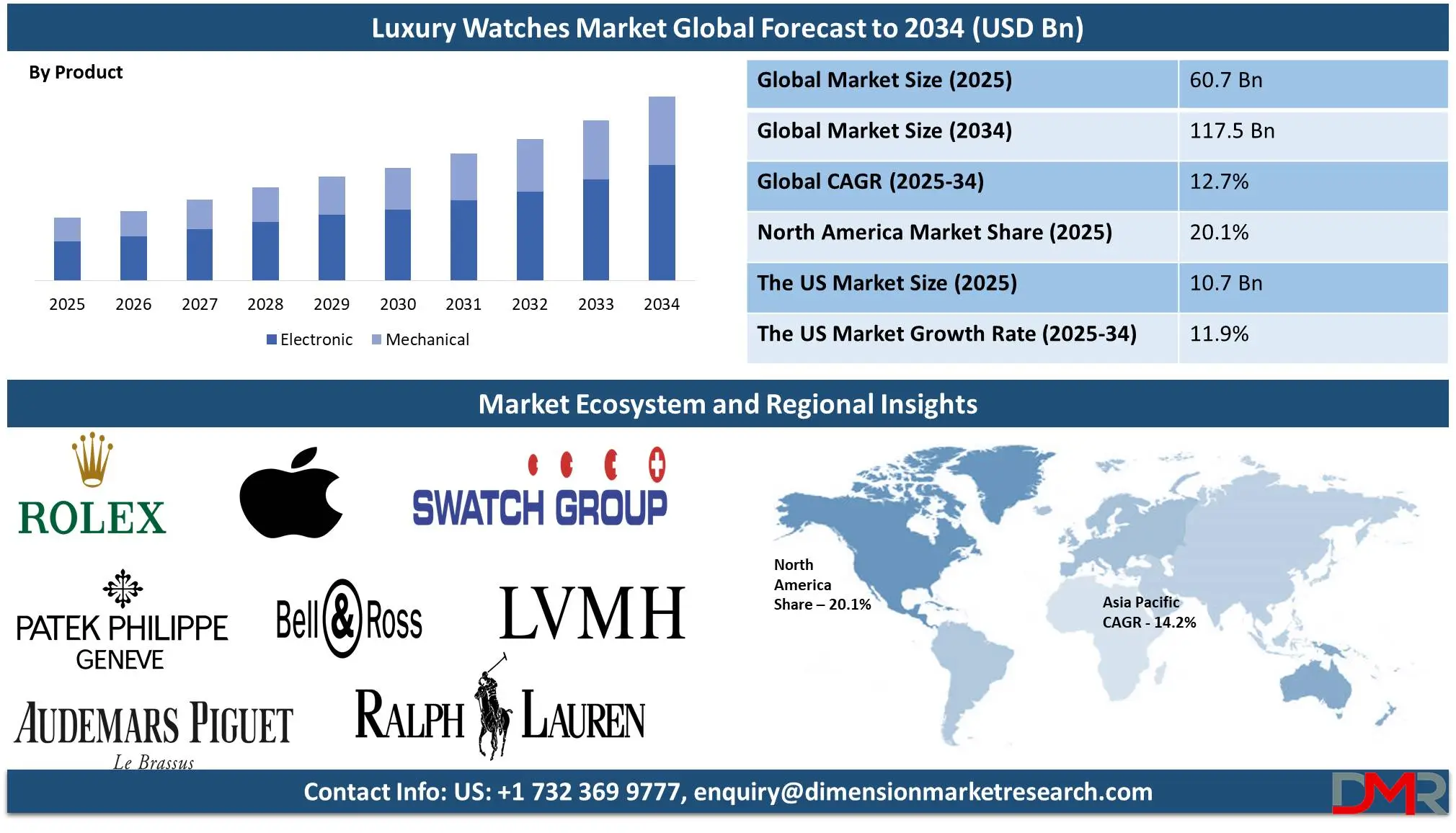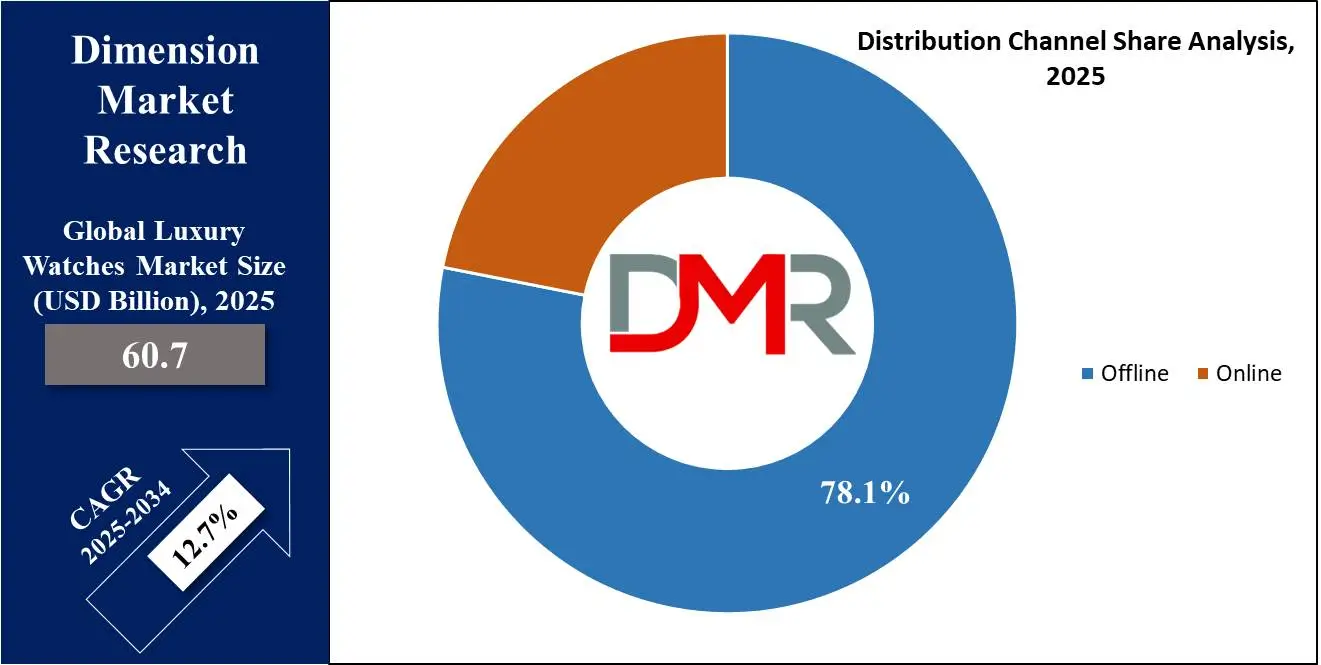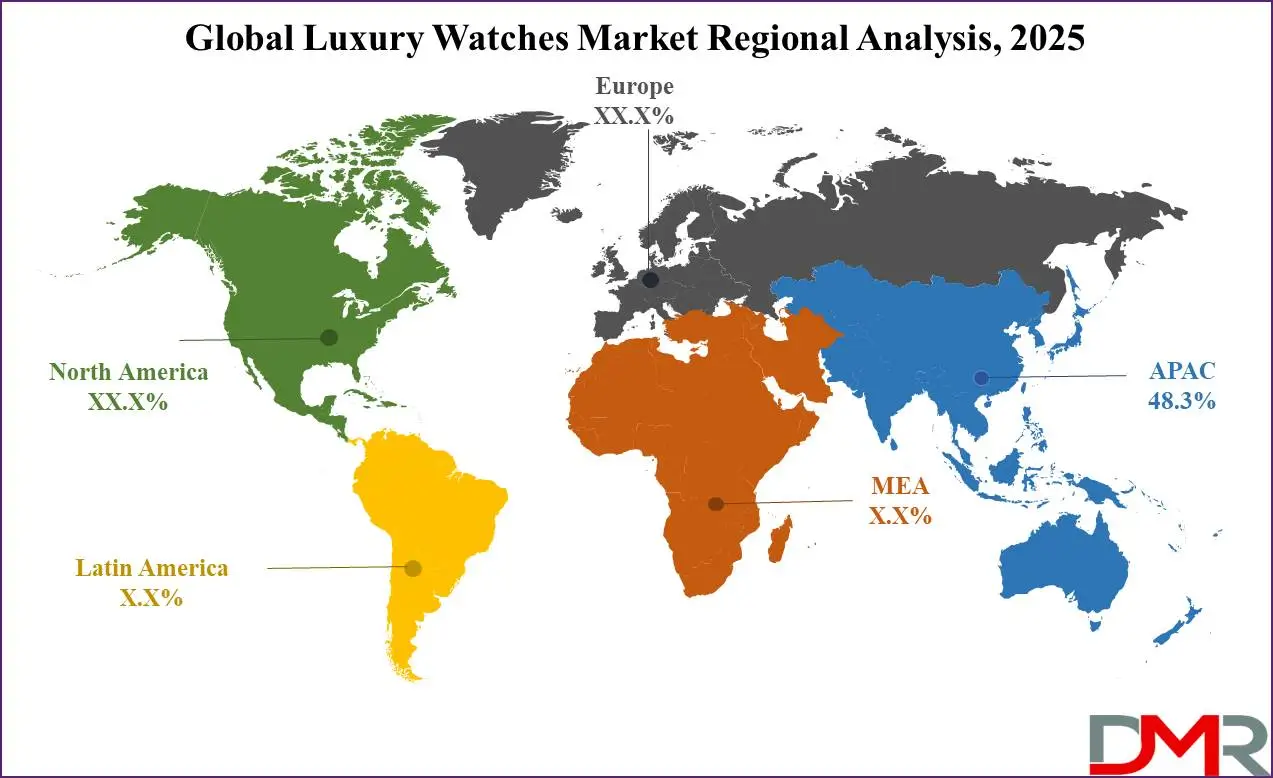
Luxury watches are symbols of craftsmanship, heritage, and prestige. These watches are primarily made from premium materials like gold, platinum, or titanium and often feature complex mechanisms like perpetual calendars, tourbillons, or moon phases. Brands like Rolex, Patek Philippe, and more define this category, blending functionality with artistry to create timeless products that are highly sought after by collectors and enthusiasts alike.
Moreover, the demand for luxury watches has grown majorly over the years, driven by the increase in disposable incomes, growing interest in luxury goods, and the growing popularity of watch collecting as a hobby. Emerging markets, mainly in Asia, have played a major role in this growth, with countries like China experiencing a higher demand. At the same time, the second-hand luxury watch market has become a booming sector, providing buyers an opportunity to own iconic pieces at competitive prices while maintaining the exclusivity associated with luxury brands.
Further, the trends in the luxury watch market show a transformation towards sustainability and personalization. Many brands are using eco-friendly practices, like using recycled materials in their designs and adopting sustainable manufacturing processes, including custom engravings or bespoke designs, which has also gained traction as buyers look for unique pieces that reflect their style. Furthermore, there is a growing demand for high-complication watches that showcase exceptional craftsmanship and technical innovation.
Also, events like the Quartz Crisis of the 1970s have had lasting impacts on the luxury watch industry. While this period forced many smaller brands to shut down, it also caused the consolidation of major players like Swatch, Richemont, and LVMH, which now dominate the industry.
Another major transformation is the reduction in demand for entry-level watches, as consumers highly prefer higher-end and second-hand luxury watches. Iconic models like the Rolex Submariner or Patek Philippe Nautilus have become investment assets, with their value appreciating over time in resale markets, which has elevated luxury watches beyond functional accessories to coveted collectibles.
As the market evolves, luxury watch brands constantly innovate while honoring their traditions. Whether through advanced complications, heritage designs, or sustainable practices, these timepieces remain timeless symbols of status and style, capturing the attention of watch lovers around the world.
The US Luxury Watches Market
The US Luxury Watches Market is projected to reach USD 10.7 billion in 2025 at a compound annual growth rate of 11.9% over its forecast period.
The US luxury watch market provides growth opportunities through higher demand for high-end timepieces driven by a growing affluent population, rising interest in investment-grade watches, and the popularity of smartwatches. In addition, the expansion of e-commerce channels, exclusive collaborations, and personalized services provides opportunities for brands to cater to a tech-savvy, fashion-conscious consumer base looking for luxury experiences.
Further, the market in the US is driven by a growing increasing interest in high-end timepieces as investments and a growth in online retail channels. However, the market experiences challenges, including competition from smartwatches offering advanced functionality and lower prices. Also, economic uncertainty and fluctuating consumer spending habits can affect demand, majorly for high-ticket luxury items, potentially slowing market growth.
Luxury Watches Market: Key Takeaways
- Market Growth: The Luxury Watches Market size is expected to grow by 109.9 billion, at a CAGR of 12.7% during the forecasted period of 2026 to 2034.
- By Product: The electronic segment is anticipated to get the majority share of the Luxury Watches Market in 2025.
- By Band Type: Chain-based segment is expected to be leading the market in 2025
- By Distribution Channel: The offline segment is expected to get the largest revenue share in 2025 in the Luxury Watches Market.
- Regional Insight: Asia Pacific is expected to hold a 48.3% share of revenue in the Global Luxury Watches Market in 2025.
- Use Cases: Some of the use cases of Luxury Watches include status symbols, investment asset, and more.
Luxury Watches Market: Use Cases
- Status Symbol: Luxury watches are mostly worn to signify wealth, success, and sophistication, making them popular among professionals and high-net-worth individuals.
- Investment Asset: Iconic models like Rolex and Patek Philippe hold or even increase in value over time, making them a viable investment option in addition to being collectibles.
- Craftsmanship and Artistry: Luxury watches highlight exceptional craftsmanship, complex designs, and technical innovation, appealing to those who appreciate fine art and engineering.
- Heirloom and Legacy: These timepieces are often passed down through generations, carrying sentimental value and a legacy of heritage and tradition.
Stats & Facts
- According to Davosa Swiss, Rolex leads the Swiss watch industry with an estimated annual production of 1 million watches, while competitors produce about 500,000 each. Patek Philippe, known for its exclusivity, makes only 60,000 watches annually. Rolex also dominates the market share with 24.9% (USD 4.42 billion), followed by Omega at 8.8% (USD 1.75 billion), Cartier at 6.7% (USD 1.63 billion), and Patek Philippe at USD 1.1 billion.
- In addition, Longines and Tissot are the top producers in volume, manufacturing 1,500,000 and 2,400,000 units annually, respectively. Fossil Group produced approximately 10,000,000 watches in 2020, generating USD 1.6 billion in revenue, and selling an average of USD 150 per watch.
- Further, the Swiss watch industry faced significant changes during the Quartz Crisis of the 1970s, which reduced the number of manufacturers from 1,600 to 600. This led to the consolidation of the market and the rise of dominant groups like Swatch, Richemont, and LVMH.
- Furthermore, watches priced above USD 8,000 account for 70% of Swiss watch sales by value, despite making up only 10% of total production. Patek Philippe reflects this trend by replacing its stainless steel Nautilus 5711 with white gold and platinum 6711.
- China experienced a 60% growth in watch market demand, helping to mitigate export losses in Hong Kong (-22%), Japan (-12%), and Korea (-22%). India, however, remains underdeveloped in the luxury watch sector due to high tariffs and taxes.
- The second-hand luxury watch market is growing rapidly, RealReal's 2021 resale report highlighted an increase in the average resale value of watches by USD 1,600 compared to the previous year.
- Also, Fashion watches dominate the non-Swiss market, with major producers including Fossil, Movado, Timex, and Invicta in the USA, Festina in Spain, and Japanese giants such as Seiko, Citizen, and Casio.
- Entry-level watch brands are losing momentum globally, including in Switzerland, as manufacturing costs rise and consumer preferences shift towards higher-end and second-hand luxury watches.
Luxury Watches Market Dynamic
Driving Factors in Luxury Watches Market
Rising Affluence in Emerging MarketsThe growing middle & upper-class populations in emerging economies, mainly in Asia, have majorly boosted the demand for luxury watches. Countries like China and India are experiencing higher spending on luxury goods due to growth in disposable incomes and an expanding base of affluent consumers, making these regions key growth drivers for the luxury watch market.
Booming Second-Hand Market and Investment Appeal
The pre-owned luxury watch market has become a major growth driver, providing collectors and new buyers access to iconic models at competitive prices. Watches like the Rolex Submariner and Patek Philippe Nautilus have also gained popularity as investment assets, with their resale values appreciating highly over time, further fueling demand.
Restraints in Luxury Watches Market
High Tariffs and Taxes in Key Markets
Luxury watches experience major barriers in markets like India, where high import duties and taxes increase their retail prices substantially, which affects potential buyers and limits market growth in countries with untapped demand, preventing luxury watchmakers from completely capitalizing on these emerging markets.
Competition from Smartwatches and Digital Devices
The growing popularity of smartwatches and wearable technology creates a challenge to traditional luxury watches. Brands like Apple dominate this segment, providing advanced features like fitness tracking and connectivity, which appeal to younger & tech-savvy consumers, diverting attention from traditional timepieces.
Opportunities in Luxury Watches Market
Expansion in Digital Sales Channels
The transformation toward e-commerce and digital platforms provides luxury watch brands with an opportunity to reach a global audience. By using online retail and virtual try-on technologies, brands can attract tech-savvy buyers while maintaining exclusivity through direct-to-consumer strategies and personalized experiences.
Growing Interest in Sustainability
Increasing consumer demand for environmentally responsible products provides an opportunity for luxury watchmakers to adopt sustainable practices. Using recycled materials, ethical sourcing, and eco-friendly manufacturing can attract conscious buyers and improve brand reputation, making sustainability a key differentiator in the market.
Trends in Luxury Watches Market
Personalization and Customization
Luxury watch buyers mainly look for distinctive, personalized timepieces that reflect their individuality. Brands are responding with customizable options like display engravings, interchangeable straps, and limited-edition designs, which enhance the emotional connection between the customer and the product, driving demand for exclusive, one-of-a-kind watches.
Rise of High-Complication Watches
There is a higher interest in high-complication watches that showcase exceptional craftsmanship and technical innovation. Features like perpetual calendars, minute repeaters, and tourbillons are gaining popularity among collectors and enthusiasts, as they demonstrate the artistry and precision of luxury watchmaking, further elevating their status as collectible items.
Research Scope and Analysis
By Product
The global luxury watch market is projected to see the electronic product segment as the leading segment in the market in 2025, making up the largest share of overall revenue, which is expected to continue, with steady growth predicted throughout the forecast period. A major factor driving this expansion is the increasing demand for smartwatches with advanced features like GPS, heart rate monitors, and multisport tracking. These watches provide users the ability to track their physical activities, like distance and speed, which makes them highly appealing to fitness enthusiasts and tech-savvy consumers.
In addition, companies like Apple Inc. are improving the appeal of their smartwatches by providing customization options, enabling customers to choose colors, materials, and specific features that suit their preferences. As a result, the electronic segment is likely to retain its leading position in the luxury watch market for the foreseeable future.
Further, the mechanical product segment is anticipated to experience the fastest growth during the forecast period. Mechanical luxury watches are mainly popular among business professionals who view them as not only functional timepieces but also as stylish accessories that make a strong statement of success and sophistication. The use of advanced materials, like titanium and ceramic coatings, along with PVD coatings, helps improve the durability and longevity of these watches, making them even more desirable. Renowned brands like Rolex, the Swatch Group, and others are major players in this segment, providing numerous mechanical watches that combine craftsmanship with luxury. As the demand for these high-end timepieces continues to rise, mechanical watches are expected to see significant growth in the coming years.
By Band Type
Based on band type, the chain-based segment of the global luxury watch market is anticipated to emerge as the largest segment in 2025, mainly due to its durability and the versatility of materials used in its construction. Chain-based watches mainly feature metal bracelets, which are made from materials like stainless steel, precious metals like gold or platinum, or a mix of these materials. These watches are favored for their durability, and many luxury timepieces, majorly limited editions, may incorporate distinctive bracelet designs that align with the theme or concept of the watch. The strength and timeless appeal of chain-based watches continue to make them a popular choice, particularly for those looking for a durable yet stylish option.
Also, the strap-based segment, while currently smaller, is expected to experience significant growth throughout the forecast period. Strap-based watches provide a unique combination of style, comfort, and flexibility. These watches mainly use straps made from a variety of materials, including leather, fabric, rubber, or synthetic alternatives, which can provide a more comfortable fit in comparison to metal bracelets. Straps are often chosen for formal or dress watches because they add an element of specialization and can easily complement different dress codes.
The ability to easily change the strap allows wearers to personalize their watches to suit different occasions or moods, making strap-based watches a versatile option, which are driving the increasing popularity and adoption of strap-based products across the global luxury watch market.
By Distribution Channel
In 2025, the offline retail segment is set to lead the luxury watch market, and it is expected to continue dominating in terms of revenue throughout the forecast period. One of the main reasons for this is that many consumers prefer buying high-end products directly from physical stores, where they can see, touch, and experience the products firsthand. Retail outlets, like convenience stores, supermarkets, and company-owned brand stores, allow customers to better look into important factors like the size, weight and overall feel of a luxury watch, which experience plays a major role in their purchasing decisions, majorly for high-ticket items, where consumers want to ensure they are making the right choice, which continues to drive the growth of the offline segment in the market.

Further, the online retail segment is anticipated to grow at the fastest rate, with a projected compound at a steady rate over the forecast period. More consumers are turning to online channels to purchase premium products due to the convenience and additional services they offer. These include benefits like cash-on-delivery options, easy returns, secure transactions, and centralized customer service, all of which make shopping online more attractive.
To keep up with this shift, many luxury watch companies, like Rolex, Fossil Group, and Ralph Lauren, have expanded their presence online while maintaining their strong retail stores. By offering products through both offline and online channels, these brands are able to increase their market reach and cater to a global customer base, which allows manufacturers to reduce operational costs and boost profitability while ensuring their products are available to customers worldwide.
The Luxury Watches Market Report is segmented on the basis of the following
By Product
By Band Type
By Distribution Channel
Regional Analysis
Asia Pacific is anticipated to dominate the global luxury watch market,
capturing over 48% of the total revenue in 2025, owing to the changing consumer behavior and the growth in disposable income of consumers in key countries like China, India, and Japan. As many people in these countries join the growing middle and upper classes, the need for luxury goods, like high-end watches, has increased significantly. Major global luxury brands are taking notice of this potential, and many are expanding their presence in these countries. Among the countries in this region, China is set to be the largest market for luxury watches, driven by a high population of wealthy individuals. As a result, the Asia Pacific region has generated the highest revenue for the luxury watch industry.

Further, North America is currently the fastest-growing market for luxury watches, with growth fueled by a combination of economic factors, evolving consumer behavior, and cultural influences. The region's elite customer base, particularly in major cities like New York, Los Angeles, and Miami, has a strong appetite for high-end products. These cities are home to numerous luxury boutiques and authorized dealers, making it easier for consumers to access luxury timepieces. Additionally, the cultural appreciation for fine craftsmanship and exclusive products continues to drive the demand for luxury watches in North America.
Meanwhile, Europe remains a key market for luxury watches, with many European countries holding a deep cultural connection to these timepieces. Luxury watches are viewed as symbols of tradition and craftsmanship in European cultures, contributing to a steady demand for these products. This strong cultural appreciation helps maintain Europe’s status as an important market for luxury watches.
By Region
North America
Europe
- Germany
- The U.K.
- France
- Italy
- Russia
- Spain
- Benelux
- Nordic
- Rest of Europe
Asia-Pacific
- China
- Japan
- South Korea
- India
- ANZ
- ASEAN
- Rest of Asia-Pacific
Latin America
- Brazil
- Mexico
- Argentina
- Colombia
- Rest of Latin America
Middle East & Africa
- Saudi Arabia
- UAE
- South Africa
- Israel
- Egypt
- Rest of MEA
Competitive Landscape
The luxury watch market is highly competitive, with several well-established brands leading the industry. Major players like Rolex, Patek Philippe, Omega, and Audemars Piguet dominate the market with their iconic timepieces known for precision, craftsmanship, and exclusivity. Newer brands and smartwatches, like Apple, are also gaining ground, providing advanced technology and customization options. Companies constantly innovate by adopting e-commerce platforms and improving customer experiences to stay ahead. The market's competitive nature pushes brands to focus on quality, design, and brand heritage to maintain their position.
Some of the prominent players in the global Luxury Watches are
- ROLEX
- Apple
- The Swatch Group
- Patek Philippe
- Bell & Ross
- Audemars Piguet
- Richard Mille
- LVHM
- Ralph Lauren
- Seiko Watch Corporation
- Other Key Players
Recent Developments
- In October 2024, Cristiano Ronaldo launched his watch collection with Jacob and Co. The line includes two models: Flight of CR7 and Heart of CR7. Both models feature a 44mm case, and some details reference the Portugal international. The models have a skeletonized movement, and their design is immaculate, with two vertical pillars signifying both Ronaldo and his CR7 brand.
- In September 2024, Titan-owned watch company Helios introduced a partnership with Italian watchmaker U-Boat to bring its premium watches to India ahead of the festive season. The company will launch 41 styles priced between INR 1.2 lakh to INR 6 lakh in the Indian market that will be available at 11 stores across key metro cities like Delhi, Mumbai, Bengaluru, Hyderabad, and Kolkata.
- In July 2024, Rolex launched its latest collection of timepieces, offering a fresh interpretation of its iconic models. These new watches, showcased at the Watches and Wonders event in Geneva, exemplify a harmonious blend of materials, colors, and textures, showcasing Rolex's unwavering commitment to excellence and innovation. Drawing on its unparalleled expertise in watchmaking, Rolex has crafted timepieces that play with contrasts, striking a perfect balance between functionality and aesthetics, performance and luxury, tradition and innovation.